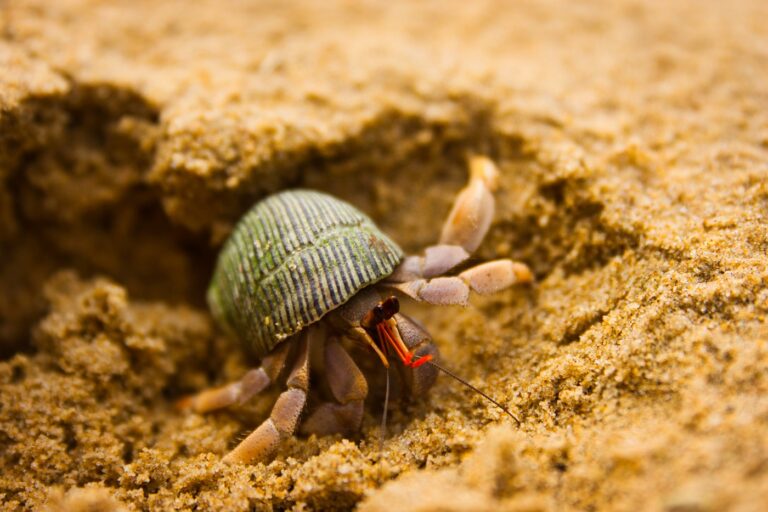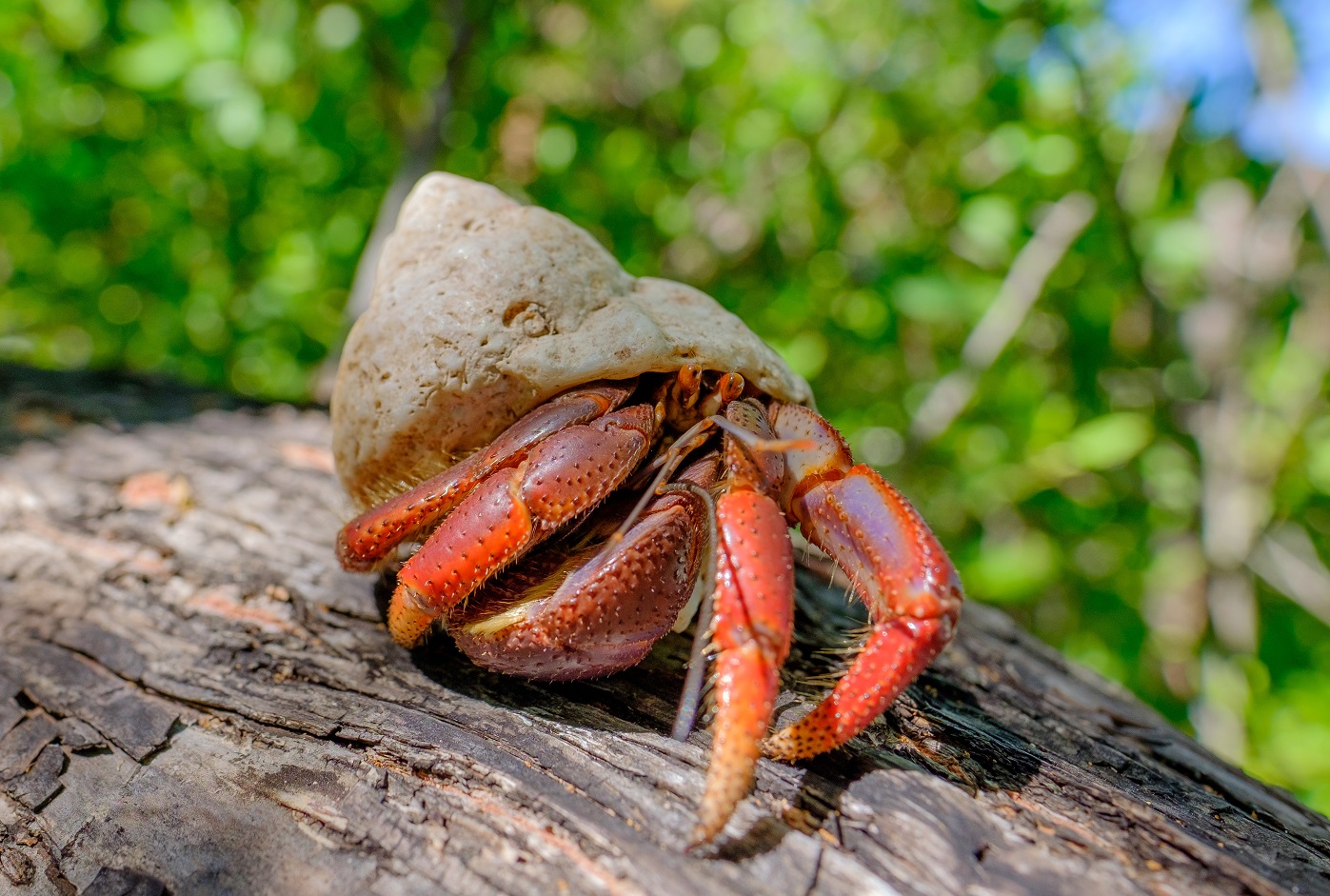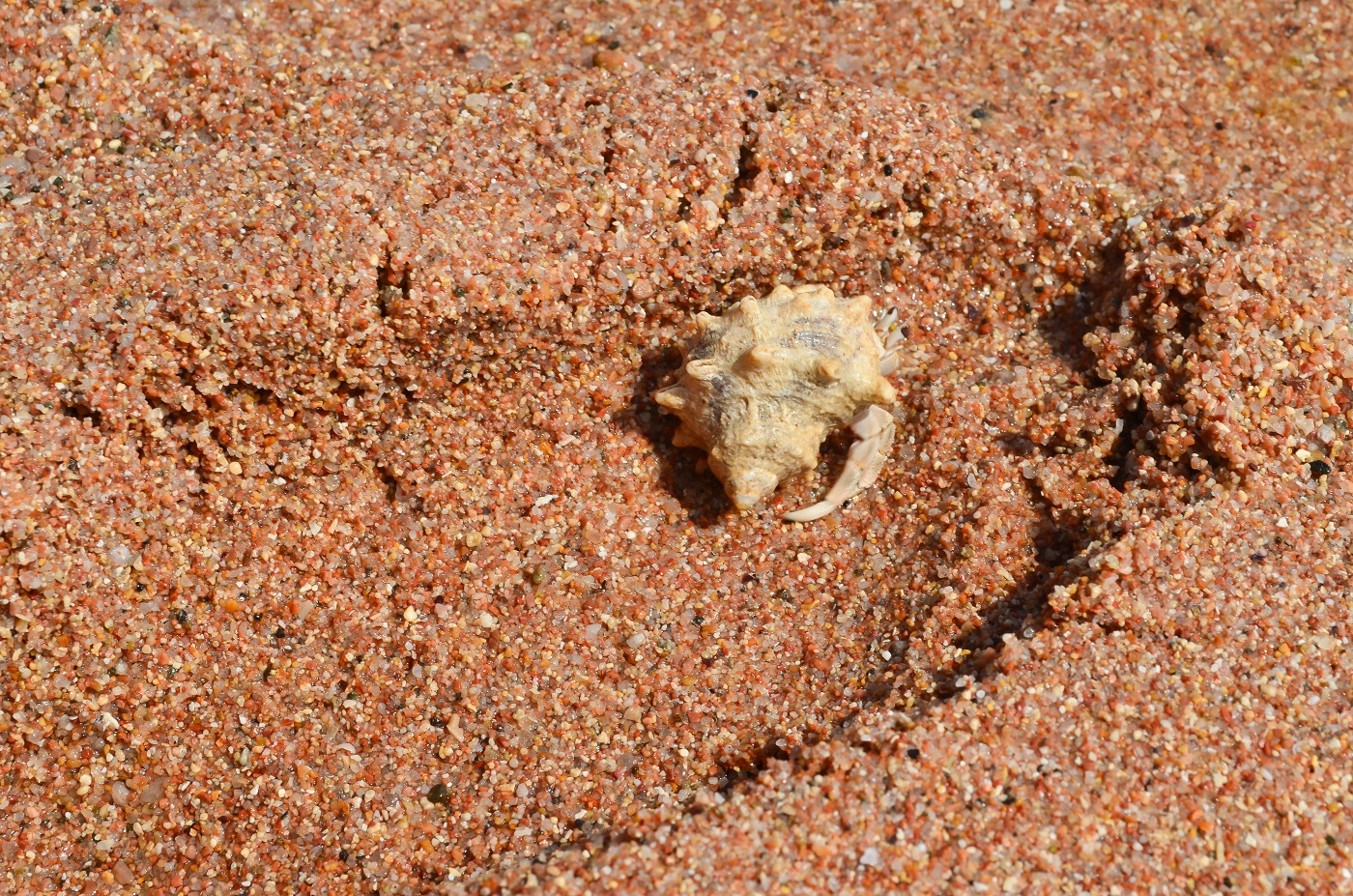Butterfly Koi
Are you looking for new carps (Cyprinus carpio) for your pond? Then you should definitely consider the Butterfly Koi. Read in this article the most important information on this beautiful Koi.
The Land Hermit Crab only lives in the water as a larva and later adapts to life on land. But what are the demands of these quirky crabs when kept by humans? Find out the most important information in this article.

© Silvio / stock.adobe.com
A Land Hermit Crab burrows into the sand on the beach.
The appearance of the Land Hermit Crab (Coenobitidae) varies depending on the species. However, they all have five pairs of legs and a body divided into three segments.
The different sized claws – also known as pincers – are found on the front legs. The left claws are always larger than the right-hand pincers. They help crabs to ingest food or defend themselves. They use the middle legs for walking and the rear legs fix the shell.
With their mandibles (mouth parts), they can also ingest food and clean their pairs of antennae, which are found on the head together with their eyes.
One of the smallest and most popular species is the Coenobita rugosus, also known as the Ruggie Hermit Crab. This crab is found in different colours with brown, red or violet accents.
However, you can find other animals in black, blue, pink or white. Their striped, spotted claws and small legs are usually bright red. In contrast, other species have no stripes on their claws.
Whilst the C. rugosus only reaches around 1.2cm in size, other species like the C. brevimanus reach up to 16cm in length.
 © Jorge Moro / stock.adobe.com
© Jorge Moro / stock.adobe.com
Land Hermit Crabs are considered very friendly and sociable. As a result, you should never keep a Land Hermit Crab on its own, but always with other crabs. A group of around three to five animals is recommended.
Your crabs shouldn’t have contact with other animals. Some crab species of the same size from the Coenobita genus are suitable for socialisation with the Land Hermit Crab.
Take enough time for your crabs – they will get used to you little by little. Most even then eat from the hands of their owners. When they are especially happy, they will let you know with a chirp that comes from rubbing their pincers.
During shedding, a Land Hermit Crab sometimes does not leave its shell for several months. During this time, it sheds its old chitin shell and gradually forms new layers. In the process, it feeds off its old exoskeleton, which contains vital nutrients.
You can use an aquarium or terrarium (paludarium) to keep Land Hermit Crabs in a species-appropriate way. The minimum size should be 80 x 40 x 40cm. The bigger the terrarium the better!
Make sure that the temperature is between 26°C and 28°C. It shouldn’t exceed 30°C in the long run. You can reduce the air temperature to 21°C at night, although it should not drop below 21°C persistently. It’s best if you monitor the temperature with an integrated thermometer.
There should also be humidity levels of 70 to 90% in the terrarium. In order to reach this, you can spray water into the tank with a spray bottle as required. However, make sure that no mildew forms. A hygrometer is practical for checking humidity levels.
Gravel, sand, humus and pine bark with a height of at least 10cm are suitable substrates. They are great for your crabs burrowing and the wood retains moisture. You can also add an infrared lamp to maintain the required temperature in the terrarium.
Caution: Crabs are very good at climbing and always find a way out of insufficiently secured terrariums, so design the tank to be escape-proof. However, you should offer your crabs stones, roots or coconut matting so they can still pursue their natural climbing instincts.
Your Land Hermit Crabs don’t want to do without shallow bodies of water either. Whilst they use the bowl of freshwater to drink and moisten their gills, they consume vital nutrients like calcium in another bowl with saltwater.
In contrast, plants provide a place to hide and opportunities to play. Almost all toxin-free plants adapted to the required climatic conditions (e.g. ferns or moss) are suitable here. A bowl with sepia acts as a necessary source of calcium.
Land Hermit Crabs grow throughout their lifetime. To do so, it changes from time to time its dwelling, which in addition to the thin shell made of chitin acts as protection against external influences. The exposed abdomen is particularly dependent on a protective shell, so don’t forget to provide your crabs with suitable shells of different sizes.
 © NataliaArkusha / stock.adobe.com
© NataliaArkusha / stock.adobe.com
Since Land Hermit Crabs are omnivores and like to have a varied diet, conventional crab food is a good choice.
Suitable supplements include toxin-free vegetables (e.g. cauliflower, peas or corn) and fruit (e.g. pineapple, banana or grapes), chopped and unseasoned meat (e.g. chicken), fish and invertebrates (e.g. shrimp). If your crabs are full and there is still leftover food in the aquarium, you should remove it regularly for hygiene reasons.
On the other hand, you cannot give your crabs food containing salt or sugar. Sweets, leftovers or pastries can cause serious damage to the health of your crabs.
Interesting fact: The colour of your crabs depends largely on what they eat. Food with high levels of zeaxanthin, a valuable carotenoid, leads to a strong yellow to red colour. This substance also protects against harmful solar radiation.
Costing around four to twelve euros each, Land Hermit Crabs are quite cheap pets. Nevertheless, there are additional costs that you shouldn’t underestimate.
On the one hand, you have to factor in basic equipment and the required technology. In addition, there are ongoing costs for food, housing and the vet.
In general, stress never promotes good health, since Land Hermit Crabs are particularly sensitive. So don’t expect them to go out too much and don’t take them into your hands too often. Land Hermit Crabs are frequently affected by shedding problems due to stress, which can unfortunately prove fatal at times.
The average life expectancy for Land Hermit Crabs is usually around 10 to 15 years. However, some owners also report animals with an age of 30 or more.
As you may already have guessed, Land Hermit Crabs live in or close to the sea in subtropical and tropical zones (e.g. islands in the Indo-Pacific). Along with salt water, they also need to be close to bodies of freshwater for their drinking requirements.
When female crabs lay eggs in the sea, the larvae hatch immediately. Throughout several larvae stages, they develop into small crabs looking for a suitable shell.
They then live on the land rather than in the sea. They seek shelter in the day in caves and the like and awaken at night.
All in all, Land Hermit Crabs are interesting pets that you can keep even as a first-time owner. If you read up on the subject, you can become a true pro in no time and give your crabs a life as species-appropriate as possible.
Are you looking for new carps (Cyprinus carpio) for your pond? Then you should definitely consider the Butterfly Koi. Read in this article the most important information on this beautiful Koi.
Guppies (Poecilia reticulata) are among the most popular fish for freshwater aquariums worldwide. They breed easily even in captivity, are easy to care for, and thus are well-suited for beginners in aquaristics. Guppies are colourful and forgiving of small mistakes. These active animals come in many varieties.
Radiantly colourful and somewhat aggressive towards other fish and conspecifics: The Siamese Fighting Fish is a remarkable creature that brings a dash of colour to any aquarium. With modest demands, this pet is incredibly easy to care for and very popular with aquaristics beginners. This article compiles the most important information about the Siamese Fighting Fish.